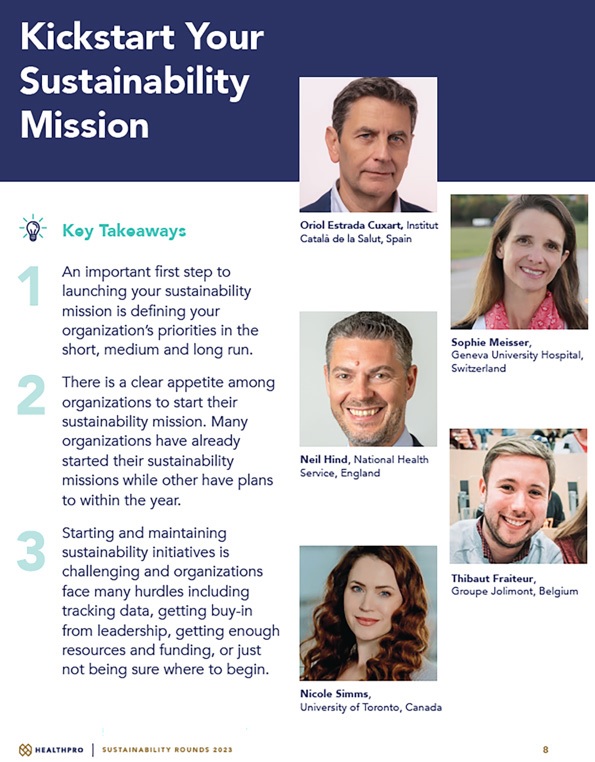HealthManagement, Volume 23 - Issue 4, 2023
Individual countries and healthcare organisations have largely been working independently – or sometimes in small partnerships – to improve sustainability and reduce the environmental damage that comes as a biproduct of healthcare provided globally. Building on these successes, Health Proc Europe and HealthPRO Canada have launched Project PROcure as a solution to connect buyers, suppliers and governments from around the world to share insights and best practices.
Key points
- The global health sector casts a significant environmental footprint.
- If the world’s health services were a country, it would be the fifth-largest carbon emitter on the planet.
- Healthcare organisations on both sides of the Atlantic are coming up with innovative solutions to clean up the environmental harm the health sector unintentionally causes as it cares for patients.
- A global coalition of partners has assembled to improve sustainability in healthcare through an innovative new initiative called Project PROcure.
Innovative Thinking Inspires Global Approach
Healthcare organisations on both sides of the Atlantic are coming up with innovative solutions to clean up a problem that has received too little attention for years – the environmental harm the health sector unintentionally causes as it cares for patients.
It’s an unfortunate reality that the health sector casts a significant environmental footprint. If the world’s health services were a country, it would be the fifth-largest carbon emitter on the planet. The combined emissions from hospitals, health services and the medical supply chain across the OECD (Organisation for Economic Cooperation and Development) group of market-based economies, as well as China and India, make up approximately 5% of the global total. This represents a larger impact than either the aviation or shipping industries.
Until the recent launch of Project PROcure – an international collaboration to advance sustainability, supply chain resilience and innovation in healthcare, there hasn’t been a global organisation focused on one of its most critical aspects – procurement – to address these challenges.
Individual countries and healthcare organisations have largely been working independently – or sometimes in small partnerships – to improve sustainability and reduce the environmental damage that comes as a by-product of healthcare provided around the world.
This article offers a selection of five curated perspectives and solutions across Europe and Canada to highlight initiatives that aim to tackle the reduction of the environmental harm caused by the healthcare industry.

Sustainable Healthcare Procurement in Europe
Procurement of medicines has been a core focus for Trine Ann Behnk for more than 20 years working in the pharmaceutical industry. Behnk serves as Group Healthcare Business Development Director with Rud Pedersen Group, a strategic European based communications consulting firm. Her background includes serving on the European Health Public Procurement Alliance organisation as a vice president for EU tenders.
In this role, she was involved in a 2022 study on best practices for public procurement for the European Commission, which examined procurement policies across 32 European countries and included the influence of healthcare procurement on protecting the environment.
In part, the study, called Study on Best Practices in Public Procurement of Medicines, found that a small but growing number of healthcare organisations are adopting environmental sustainability criteria as they procure medicines and services. It also found prior consultation with suppliers on the criteria can lead to greater success without negatively affecting prices or the number of competitors submitting bids.
Behnk said that suppliers generally want to engage with sustainability criteria through procurement – particularly when it is coordinated across jurisdictions to avoid wide variations among contracts. “They are following a clear, strict protocol with the stakeholders, together with the suppliers identifying which criteria fit in and then implementing them”, she said. “The purpose of the dominant environmental criteria is to put aside the discussion of only price. People are responding and coordinating and showing it’s possible to have well-accepted sustainable criteria, even including centralised procurement or joint procurement set up across countries”.
Behnk said she favours initiatives that enable like-minded healthcare organisations to share best practices and work towards common goals, such as environmental sustainability. “It was found during the pandemic there’s a need for healthcare organisations to learn from each other and capitalise on best practices”, she said.
Sustainable Healthcare Procurement in Canada
Through procurement, HealthPRO Canada acts as a gateway to more sustainable options for its members and suppliers.
“As Canada’s leaders in healthcare procurement, we go beyond managing contracts and supply chain. We’re forging the path to a healthier planet to enable better health overall”, said Alam Hallan, HealthPRO Canada, Clinical Director of Pharmacy, Signature Contracts. “We’re blending our healthcare procurement expertise with data-driven insights and innovative technologies on behalf of our 1,300 member-healthcare facilities nationwide to build a system that emphasises environmental responsibility at all levels of the supply chain”.
HealthPRO Canada has launched a Sustainability Toolkit to empower buyers to make more sustainable choices, including a Sustainability Scorecard, which highlights supplier performance based on established criteria in three categories – environmental, economic and social. In addition, HealthPRO Canada allows buyers to dig deeper through Impact Assessment Tools, helping them make more informed decisions at the product level. For example, hospitals can select and compare alternative anaesthetic gas options, assessing environmental impact and price based on usage.

“It’s not just about measuring the carbon footprint of the products we procure; it’s more like a compass helping direct our members and suppliers to a more sustainable future”, said Hallan. “It’s about providing the right tools and helping them bring the change we see happening nationally and internationally”.
HealthPRO Canada has also introduced regular Sustainability Rounds events that bring together hundreds of healthcare professionals, suppliers and government representatives from across the global supply chain to exchange ideas and accelerate the adoption of practical actions that have proven impact.
Environmental Leadership from Norway
Several countries in Scandinavia and elsewhere in Europe are serving as role models for their global healthcare partners who want to strengthen their environmental sustainability.
Norway has a long track record of leadership in environmental sustainability in healthcare for its innovative approaches to reducing the healthcare supply chain’s environmental impact. The Norwegian Hospital Procurement Trust (Sykehusinnkjøp HF), the national organisation which procures supplies and equipment for all Norwegian hospitals, created procurement criteria several years ago to begin phasing out harmful chemicals from healthcare products and services contracted by hospitals when safer alternatives exist.
“We have the phase-out list because we want to make sure that vulnerable patients in the hospitals are not exposed to dangerous chemicals when they are there to improve their health”, said Maiken Sele, Manager, Environment and Climate, Norwegian Hospital Procurement Trust. “That is very important to us, but also for the environment in general. We need to make sure that we pollute less”.
The Trust has been working with its partners in healthcare procurement in neighbouring Scandinavian countries and across Europe to expand the use of the phase-out list across the healthcare supply chain.
Health Care Without Harm Europe, a network of thousands of hospitals, healthcare leaders and healthcare professionals committed to more sustainable healthcare, has formally adopted the phase-out list and administers it. The phase-out list covers eight groups of chemicals of concern, including:
- Substances of very high concern
- Carcinogenic, mutagenic or substances toxic to reproduction
- Polyvinyl chloride (PVC)
- Phthalates
- Bisphenols
- Flame retardants
- Antimicrobial agents
- Per- and poly-fluoroalkyl substances (PFAS)
“The list applies to the eight chemical groups with chemicals we don’t want in any products in hospitals for environment and health reasons”, said Sele. “The environment and health are very often connected, much more connected than people often realise”.
With the support and partnership of Health Care Without Harm Europe, Sele is hopeful a growing number of healthcare facilities and their suppliers will begin to gradually replace chemicals of concern with safer alternatives. “We’re using the phase-out list to try to contribute to a more circular economy and safeguard the environment and the patients in our hospitals”, she said.
Iceland Increases Impact Through Cooperation
Landspitali, the National University Hospital of Iceland, has been able to harness the power of procurement and cooperation with healthcare organisations in neighbouring countries to significantly improve its environmental performance over the past decade.
“We have this history of cooperation among the Nordic countries and working to minimise our environmental impacts. That has affected the hospitals”, said Hulda Steingrimsdottir, Environmental Manager, National University Hospital of Iceland. “There is a great consensus on chemicals and the effect of chemicals on the environment and health. Together, that has resulted in new ideas and innovation”.
The 660-bed acute care hospital in Reykjavík has implemented several initiatives to shrink its environmental footprint, with a major focus on reducing greenhouse gas emissions related to anaesthetic gases such as nitrous oxide and desflurane.
“We have also been working on greening our travels regarding our employees and how we transport our products”, said Steingrimsdottir.
Like other healthcare organisations in Iceland, the hospital is working with suppliers to reduce and replace harmful chemicals from products and medicines when possible. Because it is relatively small, the National University Hospital of Iceland has found it can have a greater impact by working together with its healthcare partners in other Scandinavian countries to leverage their collective strength. Establishing common tender criteria on issues such as phasing out unwanted chemicals helps all players achieve their sustainability goals.
“The suppliers are happy we are working together as a group of Nordic countries (Nordic Pharmaceutical Forum). It’s better for the suppliers that we have the same criteria for them to fulfil”, said Steingrimsdottir. She recommends hospitals of all sizes work cooperatively with suppliers and introduce tender criteria to minimise healthcare’s negative impact on the planet. “It’s a very effective way to push the market. This summer and recent summers have shown us that we in healthcare need to take responsibility for our actions, and we can do that through procurement in a very effective way”, said Steingrimsdottir. “I know suppliers are also ready. If you set criteria, they are ready for you. And through that dialogue, we can change a lot”.
Practical Green Solutions in Germany
In Germany, the healthcare group purchasing organisation PEG is helping to lead the country’s shift to green healthcare practices through holistic, practical solutions. The Munich-based firm oversees procurement for approximately 400 hospitals, 700 rehabilitation clinics and more than 1,000 homes for the elderly across the country.
After more than 25 years working in healthcare, CEO Jens Leveringhaus said he and his company began to focus heavily on the sector’s environmental impact in 2020, recognising that the healthcare supply chain contributes a significant portion of Scope 3 (indirect) emissions. “Since we are a purchasing organisation … I said if it’s not us who starts moving in this direction, who else should?” he said.
PEG carried out a survey among the hospitals and health organisations it serves and found that approximately 85% of them ranked environmental sustainability as a priority, but the vast majority had not made meaningful progress in reducing their impact.
Leveringhaus set his sights on developing practical solutions to help PEG’s clients meet their goals. The company established a small environmental sustainability consultancy team that supports organisations on initiatives to achieve their targets, including Corporate Sustainability Reporting Directive (CSRD) reporting. “We are using a very systematic approach”, he said. “We are working with IT companies to provide our customers with solutions that they can move from strategy to implementation to CSRD reporting. It’s a 360-degree approach and a systematic approach”.
Leveringhaus is publishing a book to increase awareness of healthcare’s environmental footprint and provide organisations with ideas to reduce how much they contribute to the sector’s collective impact. Green Health: Sustainable Management Within Healthcare is scheduled to be released in September. “It will focus on practical examples of what hospitals and other health organisations can do to become more sustainable”, he said. “It is a book written by people with experience on the ground floor for people who want to implement similar practical projects”.
While Leveringhaus said the healthcare industry in Germany has been somewhat slow to address environmental sustainability, he’s confident there is growing recognition of the importance of taking action. “I believe that sustainability within healthcare only works if government, industry, and the public work together. I don’t think individually we’ll be able to find a solution. It has to be a systematic approach”, he said.
Project PROcure Creates a Global Solution
In recognition of the global nature of healthcare’s impact on the environment, a global coalition of partners has assembled to improve sustainability in healthcare through an innovative new initiative called Project PROcure.
The initiative was jointly founded by Health Proc Europe, a non-profit association of procurement professionals representing more than 5,000 hospitals and healthcare facilities across Europe, and HealthPRO Canada, the largest group contracting organisation for healthcare in Canada, representing over 1,300 healthcare facilities.
Born out of an international collaboration to co-create solutions to global challenges, Project PROcure connects buyers, suppliers and governments to share insights and best practices and co-create solutions. This is essential to demystifying the sustainability transformation and elucidating a pragmatic and achievable path forward.

“The climate crisis is a public health crisis, and our time is running out”, said Elisa Frenz, CEO, Health Proc Europe and Co-founder of Project PROcure. We need transformative solutions, and the only way we stand a chance is through collaboration and immediate action to strengthen partnerships among buyers and suppliers”.
Project PROcure aims to empower healthcare procurers to shape a sustainable future, guided by the UN Global Compact and the Sustainable Development Goals, European Principles for the Environment, and Canada’s Net Zero Emissions by 2050 goal.
“Project PROcure is harmonising healthcare procurement voices on global, sustainable and resilient practices to make the future of healthcare better”, said Jennifer Potvin, Vice President, Marketing, Communications and Public Affairs, HealthPRO Canada, and Co-founder of Project PROcure. “Our mission is making this transformation simple, practical and achievable. That’s what Project PROcure is all about”.
By uniting public and private healthcare buyers from across Europe and North America, Project PROcure will continuously build various products and services. Among the first are:
- A Sustainability Toolkit, which will have products added to it over time. The goal will be to help buyers make decisions based not just on price but also on greenhouse gas emissions and other key sustainability indicators.
- A comprehensive Sustainability Scorecard that will help healthcare procurement professionals make more sustainable choices based on the environmental impact of the goods and services they buy from suppliers.
- The Healthcare Buyers Community, a digital forum that brings together public and private healthcare procurement institutions, solution providers, and MedTech from across Europe, Canada and beyond. The initiative aims to create a more sustainable and efficient healthcare supply chain ecosystem by leveraging technology and data-driven solutions.
- A programme for organisations within Portugal, Belgium, Switzerland, Canada and the United Kingdom to understand how to empower procurement organisations to drive sustainability and support members in reducing Scope 3 emissions.
To engage with and learn how Project PROcure can help you advance your sustainability journey, visit https://www.healthprocanada.com/sustainability
Conflict of Interest
None.
References:
Healthcare Buyers Community. Available at https://healthcarebuyers.community/welcome
HealthPRO Canada. Procuring with Purpose. Available at https://www.healthprocanada.com/sustainability
HealthPRO Canada Impact Assessment Tools. Available at https://www.healthprocanada.com/sustainability
Healthcare Without Harm (2021) European healthcare’s phase-out list for chemicals of concern. Available at
https://noharm-europe.org/documents/european-healthcare%E2%80%99s-phase-out-list-chemicals-concern
Leveringhaus J, Wibbeling S (2023) Green Health: Sustainability Management Within Healthcare. Available at https://www.lehmanns.de/shop/medizin-pharmazie/62158720-9783954667741-green-health
Sonne F, Nielsen JT, Andreassen E et al. Nordic Pharmaceutical Forum Strategy For 2023-2025. Available at https://amgros.dk/media/3790/nlf-strategy-final.pdf
Vogler S, Salcher-Konrad M, Habimana K (2022) European Commission, European Health and Digital Executive Agency. Study on best practices in the public procurement of medicines – Final report. Publications Office of the European Union. Available at https://data.europa.eu/doi/10.2925/044781



